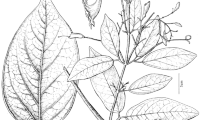Abstract
At Visakhapatnam (17°42′N-82°18′E)Zizyphus mauritiana Lam. blooms twice a year, once during September–January (first season) and again during March–June (second season). The flowers are compatible to geitono and xeno pollen. They are strongly protandrous and pass through distinct developmental stages. While the first 2 flowers of umbel are invariably complete, the succeeding ones either develop up to the male stage or continue through the female. The flowers in the 2 stages are more numerous in the first season than in the second. They decrease as the seasons progress. Two plant types occur. In one, the flowers anthese at 0600 h (early) and in the other at 1000 h (late). The stigmas of the late type receive pollen in the latter half of their receptive period, first from the early and then from the both. Those of the early type receive pollen of the late type in the beginning of receptive period, and in the last quarter first from the early and then of the both. A population with only one plant type has the stigmas receiving pollen in the last quarter of their receptive period. Pollen in the male stage and nectar in the female constitute the reward to the insect visitors that included bees, wasps, flies, ants and butterflies. The former 3 groups proved to be effecting pollination, among whichApis florea, Ceratina sp.,Trigona sp.,Ropalidia spatulata, Chrysomya megacephala andSarcophaga sp. are the major pollinators.
Similar content being viewed by others
References
Ackerman W L 1960 Flowering, pollination, self-fertility and seed development of Chinese jujube;Am. Soc. Hortic. Sci. Proc. 77 265–269
Ashton P S 1969 Speciation among tropical forest trees: some deductions in the light of recent evidence;Biol. J. Linn. Soc. 1 155–196
Baker H G 1976 ‘Mistake’ pollination as a reproductive system with special reference to the Caricaceae; inTropical trees: Variation, breeding and conservation (eds) J Burley and B T Styles (London: Academic Press) pp 161–170
Baker H G and Baker I 1973 Some anthecological aspects of the evolution of nectar-producing flowers, particularly amino acid production in nectar, inTaxonomy and ecology (ed.) V H Heywood (London: Academic Press) pp 243–264
Baker H G, Cruden R W and Baker I 1971 Minor parasitism in pollination biology and its community function: the case ofCeiba acuminata;BioScience 21 1127–1129
Chundawat B S, Srivastava H C and Bishla S S 1979 Studies on blossom biology of ber (Zizyphus mauritiana Lam.);Indian J. Hortic. 36 158–163
Corbet S A 1978 Bees and the nectar ofEchium vulgare; inThe pollination of flowers by insects (ed.) A J Richards (London: Academic Press) pp 21–30
Cruden R W 1977 Pollen-ovule ratios: A conservative indicator of breeding systems in flowering plants;Evolution 31 32–46
Darwin C 1876The different forms of flowers on plants of the same species (London: John Murrey)
Ewusie J Y 1980Elements of tropical ecology (London: Heinemann Educational Books Ltd.)
Faegri K and Pijl L Van Der 1979The principles of pollination ecology (London: Pergamon Press)
Feinsinger P 1978 Ecological interactions between plants and humming birds in a successional tropical community;Ecol. Monogr 48 269–287
Galil J and Zeroni M 1967 On the pollination ofZizyphus spina-christi (L.) Willd in Israel;Israel J. Bot. 16 15–20
Hagerup O 1932 On pollination in extremely hot air of Timbuctu;Dan. Bot. Ark. 8 1–20
Harborne J B 1973Phytochemical methods (London: Chapman and Hall)
Kirby E G and Stanley R G 1976 Pollen handling techniques in forest genetics with special reference to incompatibility; inModern methods in forest genetics (ed.) J P Miksche (Berlin: Springer-Verlag) pp 229–243
Knuth P 1906Handbook of flower pollination: Trans. J R Ainsworth Davis (Oxford: Clarendon Press)
Mehrotra K N 1983Second International Conference on Apiculture in Tropical Climates, IARI (New Delhi: Yugantar Press)
Pijl Van Der L 1978 Reproductive integration and sexual disharmony in floral functions; inThe pollination of flowers by insects (ed.) A J Richards (London: Academic Press) pp 79–88
Proctor M and Yeo P 1972The pollination of flowers (New York: Taplinger Publishing Company)
Singh D, Bakshi J C and Singh K 1970 Flowering and fruiting behaviour of ber Cv. Banarasi karaka (Zizyphus mauritiana Lam);Punjab Hortic. J. 10 21–28
Stanley R G and Linskens H F 1974Pollen: Biology, biochemistry and management (Berlin: Springer-Verlag)
Teaotia S S and Chauhan R S 1963a Flowering, pollination, fruit set and fruit drop studies in ber (Zizyphus mauritiana Lam.), I. Floral biology;Punjab J. Hortic 3 60–70
Teaotia S S and Chauhan R S 1963b Flowering, pollination, fruit set and fruit drop studies in ber (Zizyphus mauritiana Lam.), II. Pollination, fruit set, fruit development and fruit drop;Indian J. Hortic. 21 40–45
Thomas C C 1924The Chinese jujube; U.S. Dept. Agric. Bull. No. 1215
Webb C J 1985 Protandry, pollination and self-incompatibility inDiscaria toumatou;N. Z. J. Bot. 23 331–335
Author information
Authors and Affiliations
Rights and permissions
About this article
Cite this article
Devi, K.R., Atluri, J.B. & Reddi, C.S. Pollination ecology ofZizyphus mauritiana (Rhamnaceae). Proc. Indian Acad. Sci. 99, 223–239 (1989). https://doi.org/10.1007/BF03053596
Received:
Revised:
Issue Date:
DOI: https://doi.org/10.1007/BF03053596



